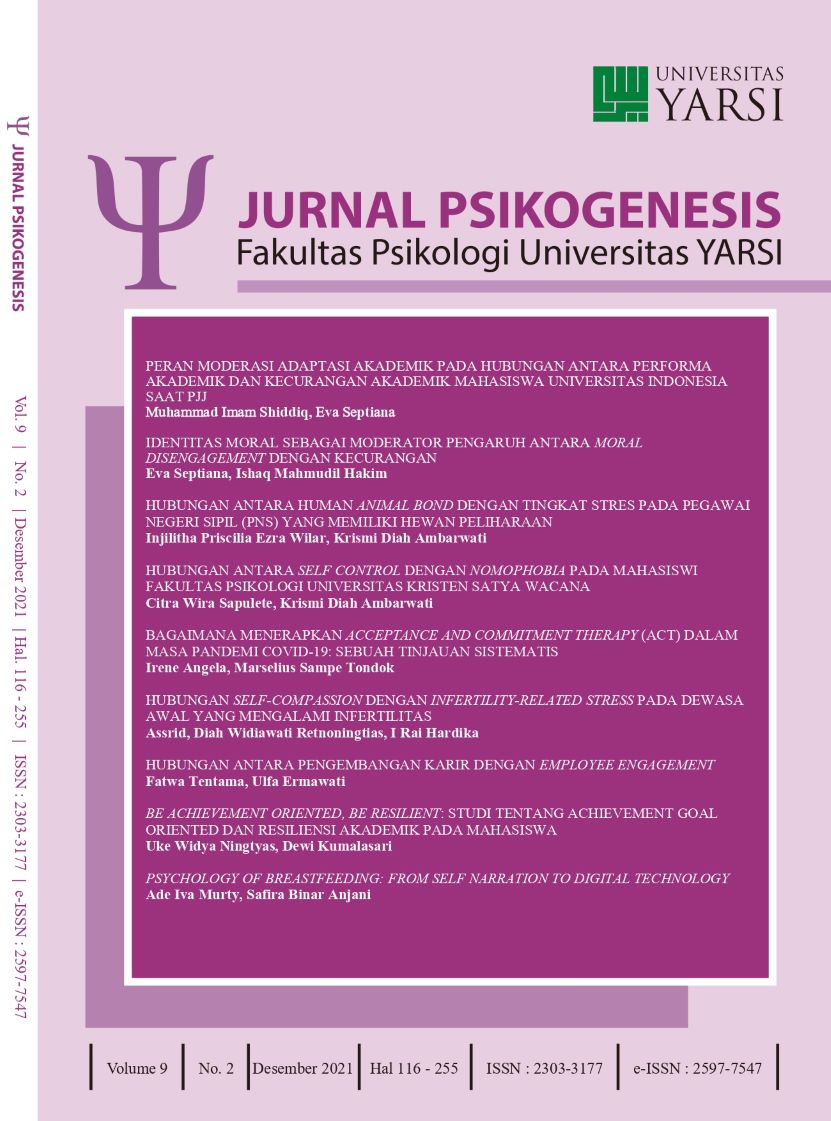Hubungan Antara Human Animal Bond dengan Tingkat Stres Pada Pegawai Negeri Sipil (PNS) yang Memiliki Hewan Peliharaan
Keywords:
human animal bond, tingkat stres, PNSAbstract
Memelihara hewan diyakini bisa membantu manusia dalam mereduksi tingkat stres. PNS yang memiliki tanggung jawab yang besar baik dalam pekerjaan maupun diluar pekerjaan, membutuhkan koping stres yang bisa diperoleh dari interaksi bersama hewan peliharaannya. Penelitian ini bertujuan untuk mengetahui hubungan antara human-animal bond dengan tingkat stres pada PNS yang memiliki hewan peliharaan. Batasan hewan peliharaan dalam penelitian ini yaitu anjing dan kucing. Penelitian ini merupakan jenis penelitian kuantitatif korelasional. Terdapat dua alat ukur yang digunakan dalam penelitian ini, yaitu Pet Attitude Scale (PAS) yang dikembangkan oleh Templer dan Arikawa (2011) dengan nilai reliabilitas alat ukur 0,857 dan Perceived Stress Scale 10 (PSS-10) yang dikembangkan oleh Cohen (1994) dengan nilai reliabilitas alat ukur 0,804. Teknik pengambilan sampel dalam penelitian ini menggunakan purposive sampling dengan memberikan kriteria khusus (Piyono, 2016). Data dalam penelitian ini diperoleh melalui penyebaran kuesioner kepada 42 PNS dengan jabatan struktural yang berdomisili di Sulawesi Utara. Berdasarkan analisis data yang telah dilakukan, hasil penelitian menunjukkan bahwa tidak terdapat hubungan negatif yang signifikan antara human animal bond dengan tingkat stres, dengan hasil uji korelasi Spearman (rxy = -0,163) dan nilai signifikansi 0,152 (p>0,05). Tidak adanya hubungan yang ditemukan dapat dipengaruhi oleh kehadiran hewan yang dapat menjadi stresor, persepsi individu terhadap stresor, faktor lingkungan kerja, dan faktor dukungan sosial yang berasal dari orang dan lingkungan sekitar. Dengan demikian, hipotesis dalam penelitian ini ditolak.References
Ambarwati, P. D., Pinilih, S. S., & Astuti, R. T. (2017). Gambaran tingkat stres mahasiswa. Jurnal Keperawatan, 5(1), 40-47. https://doi.org/10.26714/jkj.5.1.2017.40-47
Azwar, S. (2017). Metode penelitian psikologi (2nd ed.) Yogyakarta: Pustaka Belajar.
Azwar, S. (2009). Efek seleksi aitem berdasar daya diskriminasi terhadap reliabilitas skor tes. Buletin Psikologi. 17(1), 28-32. doi: 10.22146/bpsi.11479
Campo, R. A., & Uchino, B. N. (2013). Humans’ bonding with their companion dogs: Cardiovascular benefits during and after stress. Journal of Sociology & Social Welfare, 40(4), 237-259. Retrieved from https://scholarworks.wmich.edu/jssw/vol40/iss4/13
Carter, M. (2016, December 1st). Why the relationship between owners and pets is always an unconditional one. Retrieved from https://www.independent.co.uk/property/house-and-home/pets/why-pets-unconditionally-love-their-owners-dogs-cats-a7447406.html
Cohen, S. (1994). Perceived stress scale. USA: Mind Garden.
Cohen, S., Janicki-Deverts, D., & Miller, G. E. (2007). Psychological stress and disease. American Medical Association, 298(14), 1685-1687. doi: 10.1001/jama.298.14.1685
Dianovinina, K. (2018). Depresi pada remaja: gejala dan permasalahannya. Jurnal Psikogenesis, 6(1), 69-78. https://doi.org/10.24854/jps.v6i1.634
Donnelley, P. (2014, September 17th). How pets makes us more stressed, as survey reveals more than half of cat and dog owners lose sleep because their animals wake them up early. https://www.dailymail.co.uk/news/article-2758742/How-pets-make-MORE-stressed-More-half-cat-dog-owners-lose-sleep-animals-wake-early-survey-finds.html
Fadholi, A. (2014). Tumpas stres seketika. Yogyakarta: Diva Press.
Fahrani, N. S. (2020). Analisis keberadaan pegawai pemerintah non pegawai negeri sipil dalam perspektif manajemen ASN. Civil Service, vol.14(2), 65-74. Retrieved from https://jurnal.bkn.go.id/index.php/asn/article/view/276
Fata, U, H. (2016). Stress kerja perawat di ruang dahlia II RSUD Ngudi Waluyo Kab.Blitar. Jurnal Keperawatan, vol.7(1), 48-54. Retrieved from https://media.neliti.com/media/publications/137946-ID-none.pdf
Fine, A. H., & Beck, A. (2010). Understanding our kinship with animals: input for health care professionals interested in the human/animal bond. Handbook on Animal-Assisted Therapy, 3-15. https://doi.org/10.1016/B978-0-12-381453-1.10001-7
Flanrositina, S., & Ibrahim, S. M. (2019). Faktor-faktor yang mempengaruhi tingkatan stres pada tenaga kesehatan. doi: 10.31219/osf.io/he4yx
Juliadilla, R., & Hastuti, S. (2018). Peran pet (hewan peliharaan) pada tingkat stres pegawai purnatugas. Jurnal Psikologi Integratif, 6(2), 153-175. https://doi.org/10.14421/jpsi.v6i2.1488
Lady, L., Susihono, W., Muslihati, A. (2017). Analisis tingkat stres kerja dan faktor-faktor penyebab stres kerja pada pegawai BPBD Kota Cilegon. Journal Industrial Servicess, 3(1b), 191-197. http://dx.doi.org/10.36055/jiss.v3i1b.2084
Lahat, M, A., & Santosa, J. (2018). Pengaruh lingkungan kerja terhadap stress kerja karyawan pada PT Pandu Siwi Sentosa Jakarta. Aktiva- Jurnal Penelitian Ekonomi dan Bisnis, 2(2), 31-40. Retrieved from https://repository.bsi.ac.id/index.php/unduh/item/287017/JURNAL-AMAS.pdf
Lawson, P. (2019, April 4th). Laws for paws: proving you’re primary caretaker in pet custody battle. https://www.wvgazettemail.com/life/laws-for-paws-proving-you-re-primary-caretaker-in-pet-custody-battle/article_21277a57-1143-516e-8afc-40a7481c8cef.html
Lazarus, R. S. (1990). Theory-based stress measurement. Psychological Inquiry, 1(1), 3-13. https://doi.org/10.1207/s15327965pli0101_1
Lazarus, R. S., & Folkman, S. (1984). Stress, appraisal, and coping. New York: Springer Publishing Company.
Lou, J. (2016, July). Dogs and attachment theory. Retrieved from https://thebark.com/content/dogs-and-attachment-theory
Lundgren, K., Robinson, L., Segal, J. (2020, September). The mood-boosting power of pets.. retrived from https://www.helpguide.org/articles/mental-health/mood-boosting-power-of-dogs.htm
McConnell, A. R., Brown, C. M., Shoda, T. M., Stayton, L. E., & Martin, C. E. (2011). Friends with benefit: On the positives consequences of pet ownership. Journal of Personality and Social Psychology, 101(6), 1239-1252. https://doi.org/10.1037/a0024506
Pendry, P., & Vandagriff, J.L. (2019). Animal visitation program (AVP) reduces cortisol levels of university students: A randomized controlled trial. AERA Open, 5(2), 1-12. https://doi.org/10.1177/2332858419852592
Piyono. (2016). Metode penelitian kuantitatif. Sidoarjo: Zifatama Publishing.
Pop, D., Rusu, A. S., Pop-Vancea, V., Papuc, I., Constantinescu, R., Miresan, V. (2014). Psychological effects of human-animal positive interaction in dogs – review of the literature. Bulletin UASVM Animal Science and Biotechnologies, 71(2), 102-110. http://dx.doi.org/10.15835/buasvmcn-asb:10398
Pratiwi, J, S., Anward, H. H., & Febriana, S. K. T. (2013). Hubungan antara persepsi terhadap kebisingan dengan stres karyawan. Jurnal Ecopsy, 1(1), 38-41. http://dx.doi.org/10.20527/ecopsy.v1i1.484
Purnama, K. W., Wahyuni, I., & Ekawati. (2019). Faktor-faktor yang berhubungan dengan stres kerja pada pegawai negeri sipil badan penanggulangan bencana daerah (BPBD) Kota Semarang. Jurnal Kesehatan Masyarakat, 7(4), 246-253. Retrieved from https://ejournal3.undip.ac.id/index.php/jkm/article/view/24386
Rakuten Insight. (2018, July 13rd). Pet market in Asia. Retrieved from https://insight.rakuten.com/pet-market-in-asia/
Robinson, I. (1995). The Waltham book of human-animal interaction: Benefits and responsibilities of pet ownership (1st ed). British: PERGAMON.
Russow, L. (2002). Ethical implications of the human-animal bond in the laboratory. ILAR Journal, 43(1), 33-37. https://doi.org/10.1093/ilar.43.1.33
Sarafino, E. P., & Smith, T. W. (2011). Health psychology: Biopsychosocial interaction (7th ed). USA: John Willey & Sons, Inc.
Siyoto, S., & Sodik, M, A. (2015). Dasar metodologi penelitian. Yogyakarta: Literasi Media Publishing.
Smolkovic, I., Fajfar, M., & Mlinaric, V. (2012). Attachment to pets and interpersonal relationships: Can a four-legged friend replace a twi-legged one?. Journal of European Psychology Students, 3(1), 15-23. http://doi.org/10.5334/jeps.ao
Suci, I, S, M. (2018). Analisis hubungan faktor individu dan beban kerja mental dengan stress kerja. IJOSH, 7(2) 220-229.
Templer, D. I., Salter, C. A., Dickey, S., Baldwin, R., & Veleber, D.M. (1981). The construction of a pet attitude scale. The Psychological Record, 31(3), 343-348. htpps://doi.org/10.1007/BF03394747.
Templer, D. I., & Arikawa, H. (2011). The psychology of the human-animal bond, The Pet Attitude Scale. In Blazina, C., Boyraz,G., Shen-Miller,D (Eds). The Psychological of the Human-Animal Bond (335-359). New York: Springer New York.
Undang-Undang No 5 Tahun 2014. (2014, September 15th). Undang undang tentang aparatur sipil negara. JDIH BPK RI. Retrieved from https://peraturan.bpk.go.id/Home/Details/38580/uu-no-5-tahun-2014
Wade, S. (2017). Examining stress and pet/stuffed animal attachment levels with college student. University Social Sciences Research Journal. 4(1), 1-13. Retrieved from https://journals.tdl.org/ssrj/index.php/ssrj/article/download/40/26
Wartono, T., & Mochtar, S. (2015). Stres dan kinerja di lingkungan kerja yang semakin kompetitif. KREATIF: Jurnal Ilmiah Prodi Manajemen Universitas Pamulang, 2(2),153-171. http://dx.doi.org/10.32493/jk.v2i2.y2014.p%25p
Wells, M. (2017). The effect of pet ownership on college students’ stress levels. Scholars: Journal of Undergraduate Research. (29), 1-12. Retreived from https://www.mckendree.edu/academics/scholars/wells-issue-29.pdf
Widhiarso, W. (2012, May 29th). Tanya jawab tentang uji normalitas. Retrieved from http://widhiarso.staff.ugm.ac.id/files/Tanya%20Jawab%20tentang%20Uji%20Normalitas.pdf
Widhiarso, W. (2017, March 12nd). Pengategorian data dengan menggunakan statistic hipotetik dan statistik empirik. Retrieved from http://widhiarso.staff.ugm.ac.id/wp/wp-content/uploads/Widhiarso-Pengategorian-Data-dengan-Menggunakan-Statistik-Hipotetik-dan-Statistik-Empirik.pdf
Wu, C. S. T., Wong, R. S. M., & Chu, W. H. (2018). The association of pet ownership and attachment with perceived stress among Chinese adults. Anthrozoös, 31(5), 577-586. https://doi.org/10.1080/08927936.2018.1505269
Downloads
Published
How to Cite
Issue
Section
License
Authors who publish with this journal agree to the following terms:- Authors retain copyright and grant the journal right of first publication with the work simultaneously licensed under a Creative Commons Attribution License that allows others to share the work with an acknowledgement of the work's authorship and initial publication in this journal.
- Authors are able to enter into separate, additional contractual arrangements for the non-exclusive distribution of the journal's published version of the work (e.g., post it to an institutional repository or publish it in a book), with an acknowledgement of its initial publication in this journal.
- Authors are permitted and encouraged to post their work online (e.g., in institutional repositories or on their website) prior to and during the submission process, as it can lead to productive exchanges, as well as earlier and greater citation of published work (See The Effect of Open Access).

 Injilitha Priscilia Ezra Wilar
Injilitha Priscilia Ezra Wilar
 Universitas Kristen Satya Wacana
Universitas Kristen Satya Wacana











